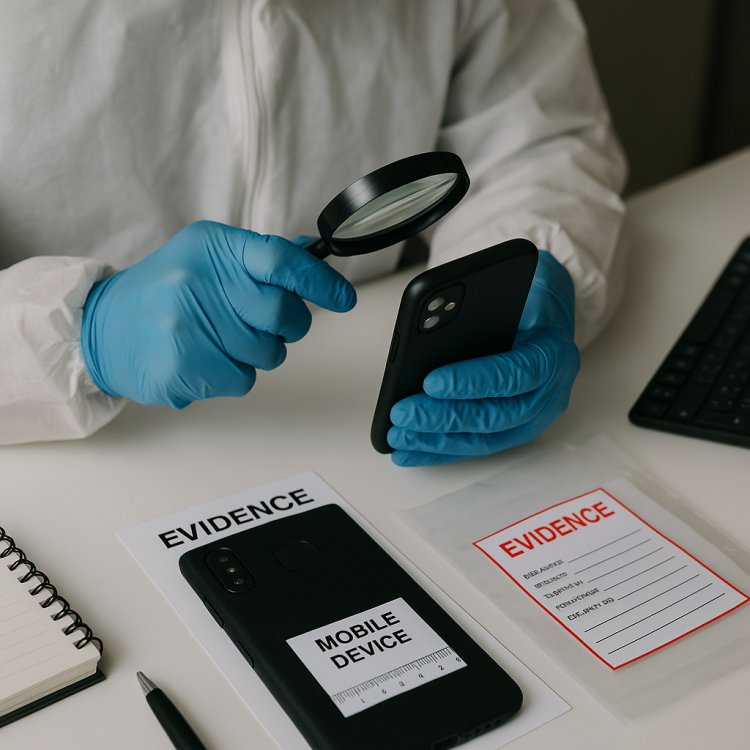Comprehensive Overview of Mobile Forensics in Investigations*
Mobile forensics is a branch of digital forensics that focuses on recovering, analyzing, and preserving data from mobile devices like smartphones, tablets, and GPS systems. It involves specialized tools and techniques to extract valuable evidence—even from damaged or locked devices—without altering the original data.

Ø What is Mobile Forensics?
Mobile forensics is a branch of digital forensics that focuses on recovering, analyzing, and preserving data from mobile devices like smartphones, tablets, and GPS systems. It involves specialized tools and techniques to extract valuable evidence—even from damaged or locked devices—without altering the original data.
- Phones Store a Lot of Information
Mobile phones have: - Call logs
- Text and WhatsApp messages
- Photos and videos
- Social media activity
- Location history
- Notes, documents, and more
This data helps police and forensic teams understand what a person was doing, where they were, and who they were talking to.
- Finding Connections
Forensic experts can find links between criminals, victims, and places. For example, they can see if two suspects were messaging each other or if someone was near the crime scene at a certain time. - Getting Deleted Data
Even if someone tries to delete messages or photos, experts can recover deleted data using special software. So criminals can’t easily hide what they did. - Proving Lies or Truth
Phone data can prove if someone is lying or telling the truth. For instance, if someone says they were at home, but the phone GPS shows they were at the crime scene—then their alibi is false.
Ø Used in a Wide Range of Investigations:
Mobile forensics plays a vital role in:
- Criminal Investigations – Murder, assault, theft, kidnapping
- Cybercrime – Online fraud, hacking, sextortion
- Terrorism & National Security – Tracking sleeper cells, digital propaganda
- Corporate Investigations – Data leaks, insider threats
- Family Law – Divorce cases, custody battles, harassment
- Accident & Insurance Claims – Confirming distraction (e.g., texting while driving)
Ø Method of Mobile Extarction:
1. Manual Extraction
This is the most basic method.
- The expert looks through the phone screen and takes screenshots or notes of what they see.
- Used when tools can’t connect to the phone or when quick access is needed.
2. Logical Extraction
- Includes: contacts, call logs, messages, photos, calendar, etc.
- Fast and safe method.
- Doesn’t get deleted files or deep system data.
3. File System Extraction
A more advanced method that pulls both user data and internal files of the phone.
- Gets app data, internal files, settings, and logs.
- Helps recover deleted files and app usage history.
- Used on unlocked or partially accessible phones.
4. Physical Extraction
- Copies the entire memory of the phone, bit by bit.
- Can recover deleted messages, hidden files, and app data, even if wiped.
- Needs special tools and sometimes works only on older or vulnerable phones.
5. Cloud Extraction
If a suspect uses cloud services (like Google Drive, iCloud, WhatsApp Backup), forensic tools can extract data directly from the cloud.
- Needs access credentials or tokens.
- Can pull emails, chat backups, photos, and more—even if the phone is damaged or lost.
ØChallenges in Mobile Forensic Investigations
Mobile forensics is very useful in solving crimes, but it also comes with many challenges.:
1. Locked Phones and Passwords
- Many phones are protected with PINs, passwords, or face/fingerprint locks.
- If the phone is locked, it becomes hard to access the data inside.
- Breaking these locks may take time, or sometimes it's not even possible without the right tools.
2. Strong Encryption
- New smartphones use advanced encryption to protect user data.
- Even if the phone is unlocked, the data inside can be scrambled and unreadable.
- Special tools and knowledge are needed to read this encrypted data.
3. Frequent Software Updates
- Phone companies like Apple and Android often update their operating systems.
- These updates can block forensic tools from accessing the phone.
- Investigators have to keep updating their tools to keep up.
4. Too Many Different Devices and Apps
- There are thousands of phone models and millions of apps.
- Each one stores data differently.
- Investigators must understand many types of phones, apps, and data formats.
5. Data Stored in the Cloud
- Some important data may be stored in cloud services like Google Drive, iCloud, or WhatsApp Backup.
- If the investigator doesn’t have the username and password, they can’t access the cloud data easily.
6. Remote Wipe and Auto-Delete Features
- Some apps or phones have "auto-delete" or "remote wipe" features.
- That means a suspect can delete data from far away, or data can disappear after a set time.
- If the phone isn’t secured fast, valuable evidence may be lost.
7. Time Pressure
- Investigators need to act quickly.
- Delays can lead to:
- Phone getting locked permanently
- Data being deleted
- Remote wipe happening
8. Legal and Privacy Issues
- Investigators must follow the law and get proper permission (warrants) before checking a phone.
- If they don’t follow the rules, the evidence might not be accepted in court.
ØConclusion:
Mobile forensics plays a vital role in uncovering digital evidence from smartphones.
Despite challenges like encryption, locked devices, and data deletion, experts use advanced tools to recover valuable information.It is now a key part of modern investigations, helping law enforcement find the truth and ensure justice.
Follow cyberdeepakyadav.com on
Facebook, Twitter, LinkedIn, Instagram, and YouTube
What's Your Reaction?























